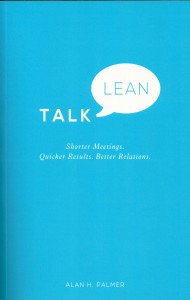The one-sentence summary
Talking lean means combining directness with politeness to develop quicker results and better relations.
WHAT THE BOOK SAYS 
· You can benefit from shorter meetings, quicker results and better relations by following a method developed by a French company called Interactifs.
· Surveying over 60,000 people over 20 years, they all answer pretty much the same to the question: How would you like to be spoken to? People want:
· Content: clear, direct, straight to the point, simple, precise, concise, concrete
· Manner: polite, calm, respectful, courteous, warm, with humour if possible.
· Most meetings and conversations are opened without reference to real intentions. Changing this makes everything work better. Start at the end (your objective) and work back.
· Three elements interlock to make this work:
1. My meeting objective.
2. What I did to prepare the meeting.
3. My state of mind.
· These preparation stages are reversed in the announcement of the purpose of the meeting: state of mind > what was prepared > meeting objective.
Three things affect levels of understanding:
1. Unsaid: things that are thought or felt but not mentioned.
2. Said: uttered, but counterproductively.
3. Ineffective listening: rigorous listening crucially involves listening to yourself.
WHAT’S GOOD ABOUT IT
· The best way to truly understand what the other person is saying is to write it down – without bias or changing their words.
· An objective of influence is to get someone to agree with your point of view.
· An objective of production is agreeing what needs to happen.
· Meetings advance successfully on one of three paths:
1. Him/Her: finding out what the other person is really thinking
2. Me: telling the other person what you really think and getting a reaction.
3. Us: finding a solution and/or launching an action.
· “What do you think of what I just said?” is a very powerful question.
WHAT YOU HAVE TO WATCH
· A bibliography would have been useful.
· The frequent use of capitals for emphasis implies a somewhat hectoring feel that is arguably at odds with the sensitivity of the technique – italics would perhaps have been softer on the page.
